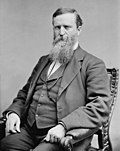| |||||||||||||||||||||
| |||||||||||||||||||||
 County results Sherman: 40-50% 50-60% 60-70% 70-80% 80-90% Kinne: 30-40% 40-50% 50-60% 60-70% 70-80% | |||||||||||||||||||||
| |||||||||||||||||||||
| Elections in Iowa |
|---|
 |
The 1883 Iowa gubernatorial election was held on October 9, 1883. Incumbent Republican Buren R. Sherman defeated Democratic nominee L. G. Kinne with 50.15% of the vote.


